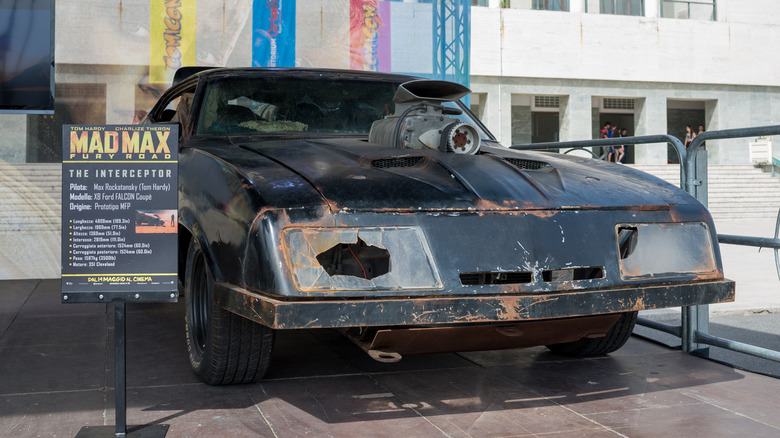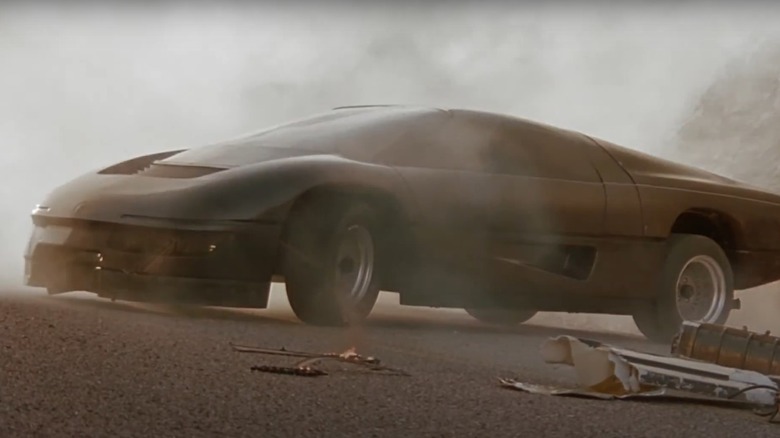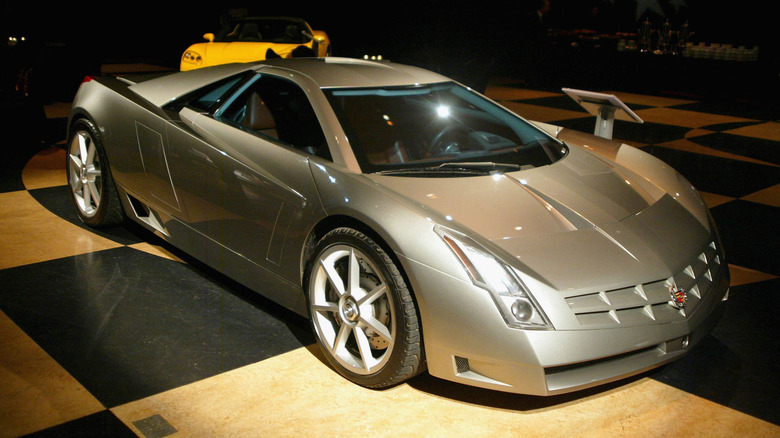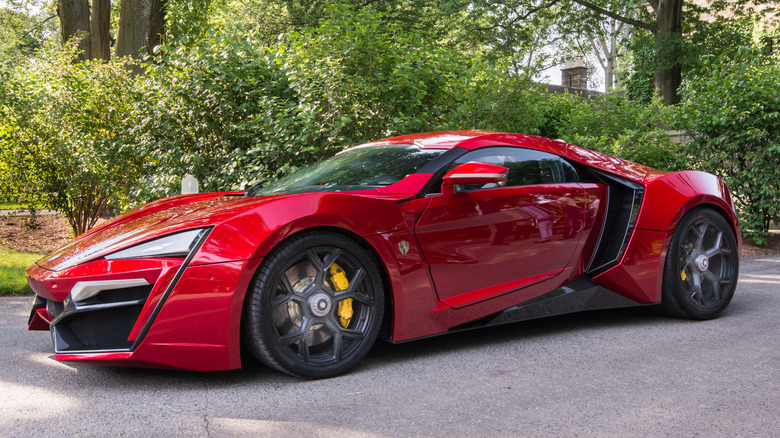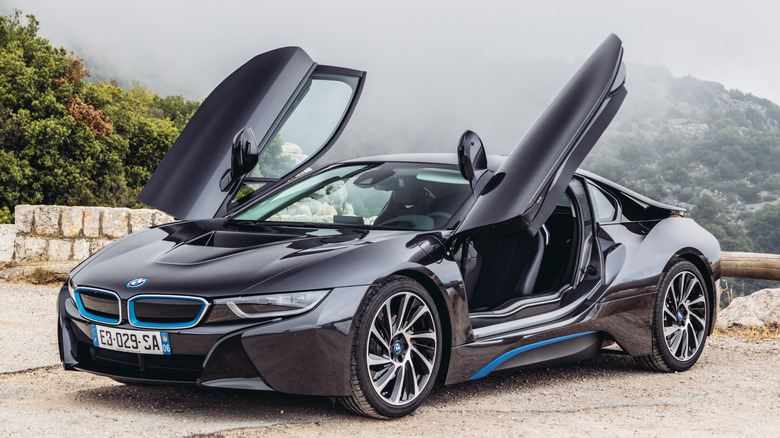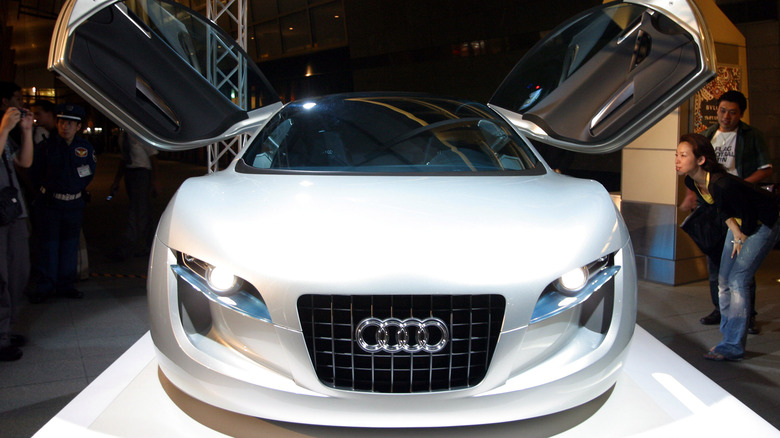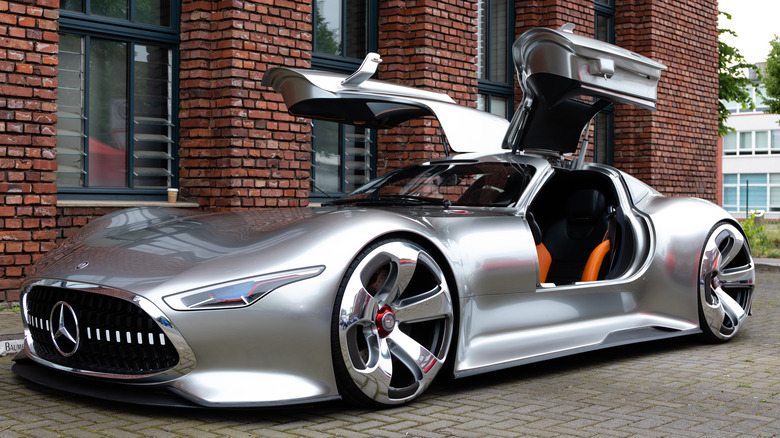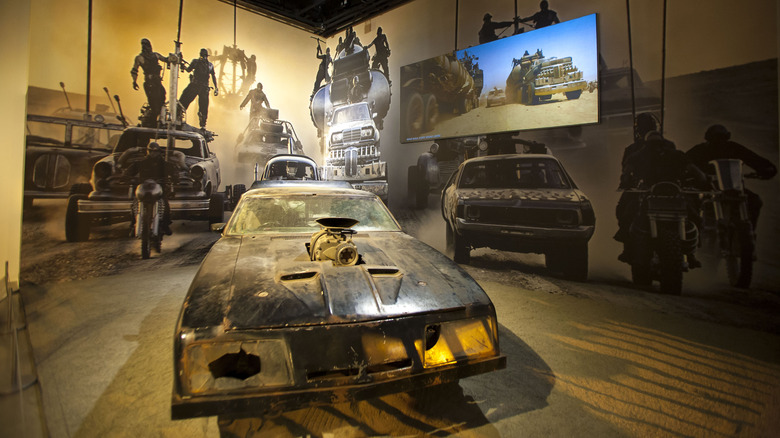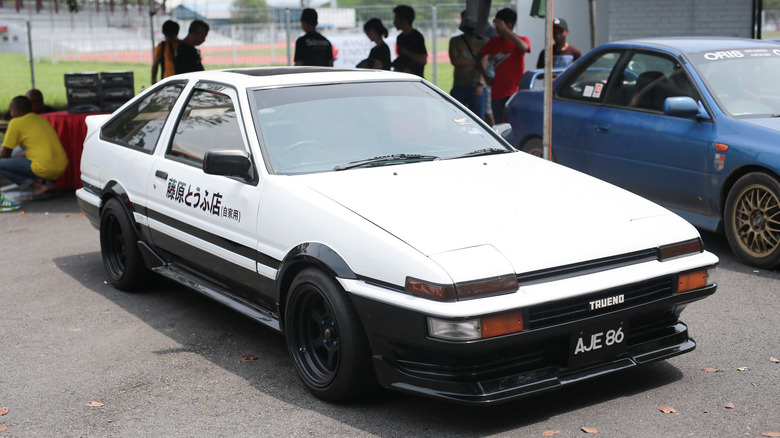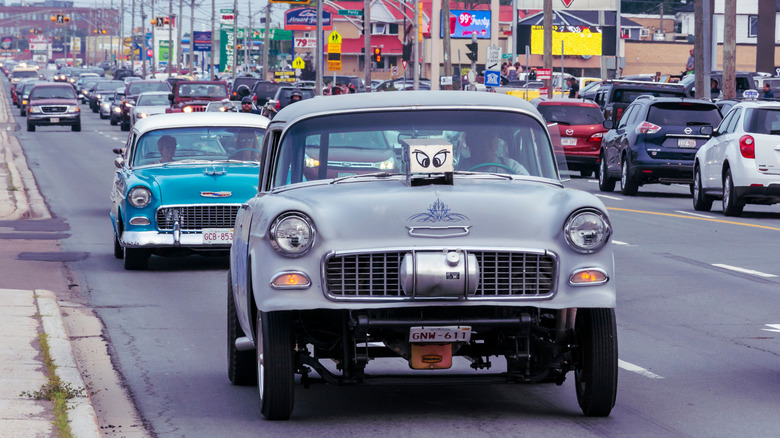Movie Cars You Didn't Realize Actually Exist
The most iconic movie cars can be just as famous and recognizable as their human costars. For Hollywood vehicle coordinators, car casting is a serious task, and a hero car should reflect the strength, wealth, and style of its protagonist. Choice of vehicle can say a lot about a character's personality, background, where their priorities lie, and what they hope to accomplish by the time credits roll.
Some more realistic films will just pull contemporary vehicles off the showroom floor, as in "Bullitt" or "Transformers." Others will modify existing cars to match a fantastical setting, like the time machine in "Back to the Future," or the Ecto-1 in "Ghostbusters." Many futuristic sci-fi pictures will also collaborate with present-day automakers, and borrow existing concept cars to give them the feel of a possible future 50 years down the line. Without further ado, let's talk about some favorite on-screen cars, along with their lesser-known real-life examples.
Dodge M4S (The Wraith)
The M4S was a fascinating concept race car built by Dodge that went on to star in one of the strangest slasher films of the mid-'80s, "The Wraith" (via Auto Evolution). The movie about an undead street racer hell-bent on revenge managed to luck into a high-profile cast, with early career performances by Charlie Sheen, Sherilyn Fenn, Randy Quaid, and Clint Howard. The titular Wraith is usually silent and clad in black racing gear, so the car really takes front and center on-screen. It seems to possess supernatural powers; able to drive away unscathed from numerous fatal collisions, and the futuristic Dodge design helps sell its otherworldliness throughout the film.
Before its starring part, the M4S was created as a fully-functioning race car in 1981, and it featured plenty of cutting-edge tech for the time (via Allpar). Dodge farmed the design out to Specialized Vehicles Inc. in Michigan, which created a swooping aerodynamic body with gullwing doors and a mid-engine layout. The engine of choice was a Chrysler 2.2 four-cylinder, ironically similar to what you'd find in its pedestrian K car lineup. However, this version of the motor was far less tame after being fitted with a Cosworth dual-cam head and a sophisticated twin-turbo system, rated at 440 horsepower. The concept also proved it could reach up to 195 mph in top-speed testing.
Only a few examples were built, but one made its way onto the set of "The Wraith," where it was used for hero shots. Six clones were made for the film, most being destroyed in the many crash scenes.
Cadillac Cien Concept (The Island)
In 2005, Michael Bay directed the high-concept (for Michael Bay) sci-fi film "The Island." The setting takes place in a dystopic future where clones are raised on an island to provide spare organs for the rich and famous. Ewan Macgregor plays one of these clones, and escapes the island to go on a rip-roaring adventure. Macgregor's "other" is a successful engineer, driving a sleek and sexy Cadillac sports car, which is promptly involved in the movie's mandatory car chase.
The original Cien was created as a design exercise in 2002, beginning a long line of breathtaking Cadillac concepts that would never make it to production. This was the first time the brand attempted a carb mid-engine supercar design, using carbon fiber chassis, and a 7.5-liter V12 making a claimed 750 horsepower (via GM Authority). To put the power down, GM pulled a six-speed auto gearbox out of the parts bin, which could be controlled using paddle shifters. The V12 uses Northstar branding, so it is likely based on that notorious dual overhead cam design. The car never saw much real-world use, nor did its engine ever go into a street car. It does, however, have a spiritual successor over on the Chevrolet side, with the release of the mid-engine C8 Corvette.
The short chase scene in "The Island" is really the only glimpse we get of how the vehicle was intended to perform. To Cadillac's (or the sound editor's) credit, it does give the high-revving growl you would want out of an engine with those specs. The car is currently housed at the Petersen Museum in Los Angeles, and is available for public viewing.
Lykan Hypersport (Furious 7)
One of the more noteworthy set pieces in "Furious 7" features the Lykan Hypersport supercar locked away in an Abu Dhabi high-rise. Our heroes, played by Vin Diesel and Paul Walker, need to extract the car. So they simply drive it out the window, and through the neighboring skyscraper. The scene is ridiculous, even for a late "F&F" sequel, but it does well to represent this equally ridiculous car.
This film is likely the first time viewers have seen anything like this, so they may think that the Hypersport was dreamed up by "Furious 7's" crew. However, seven actual examples of the Lykan have been created by Lebanese automaker W Motors, each one carrying over a $3 million price tag. The car uses a 3.7-liter flat-six engine, putting out 780 horsepower, which can be had with either a six-speed manual, or a seven-speed PDK transmission. The drivetrain is sourced from Porsche tuner RUF, which maintains plenty of cred when it comes to reliable performance (via HotCars).
The "Furious 7" prop designers actually made more Lykan Hypersports for the building jump sequence than exist in reality. The production built 10 fiberglass copies of the design using basic Porsche Boxster engines (via Top Gear). The majority of the stunt cars were either battered during filming, or completely destroyed. However, at least one of them went on to be used in the "Fast & Furious" live show.
BMW i8 (Mission Impossible: Ghost Protocol)
The BMW i8 hybrid sports car made its debut to much of the world being driven by Tom Cruise in "Mission Impossible: Ghost Protocol." It's certainly the kind of thing a superspy would drive, if they didn't care at all about being inconspicuous. The concept model of the i8 struts its stuff during a brief stunt sequence through Mumbai, displaying some features that never made it into production. The car appears to have a massive heads-up display across its entire windshield, as well as some totally egregious light-up body panels.
A few years after the film, the street version of the i8 coupe dropped, making a combined 362 horsepower out of its gas and electric drivetrain, with all-wheel drive. Despite its aggressive looks and quick acceleration, it gets a responsible fuel economy. The i8 can also drive just over 20 miles on pure electric power, which could come in handy if you need to silently tail a rival spy (via the Los Angeles Times).
Audi RSQ (I, Robot)
The 2004 film "I, Robot," very loosely based on a collection of short stories by futurist Isaac Asimov, is brimming with every action sci-fi cliché that viewers craved in post-"Matrix" cinema. Will Smith's detective character is way too cool for the distant future of 2035. He wears black leather and vintage Chucks, conveniently from the year the movie came out. He also drives the fashionable Audi RSQ, which comes in handy when he gets stuck in the middle of a violent robot uprising (via Top Gear).
The Audi RSQ design was created specifically for "I, Robot," but it obviously drew from the same inspirational well that had made the Le Mans supercar concept around the same time. The Le Mans, with minor changes, then became the Audi R8 production model. Through the power of very dated CGI, the RSQ features full self-driving, omnidirectional steering, and a seemingly indestructible body. None of those things made it into the Audi R8, but it looks cool, anyway.
Today's Audi R8 comes in both coupe and spyder configurations, with both utilizing a mid-mounted V10 engine making just over 600 horsepower. Intelligent all-wheel drive and a seven-speed auto transmission put that power down in a fairly civilized manner, shooting it up to 60 mph in just over three seconds (via Car and Driver).
AMG Vision Gran Turismo (Justice League)
The AMG Vision Gran Turismo is one of the more outlandish concepts released by Mercedes in recent years, representing a cyberpunk, retro-future take on their classic gullwing design. The AMG was first envisioned in 2013 as a playable car in Sony's "Gran Turismo 6," thus the model name. The digital ride was powered by a simulated version of AMG's turbo V8, making a healthy 585 horsepower (via Motor1.com).
A few years later, Mercedes slated the Vision Gran Turismo for a physical release, showing up as Bruce Wayne's personal whip in "Justice League" (via Motor1.com). It's a suitably ridiculous car for an over-the-top billionaire character. It's hard to say how functional the AMG used in the film is, but it can at least move under its own power. Over in the real world, Mercedes has a competent counterpart to the Vision, known as AMG ONE.
AMG ONE hearkens less to classic designs, and instead leans on modern Formula 1 technology. It starts with a small-displacement 1.6-liter, V6 turbocharged with up to 574 horsepower. This engine is part of a sophisticated hybrid system with not one, but four electric motors. Each one drives a wheel, giving the car all-wheel drive, and a total output of over 1,000 horsepower (via Mercedes).
Ford Falcon Interceptor (Mad Max)
The imposing black V8 Interceptor is one of the coolest things to come out of the "Mad Max" franchise. The muscle car is teased at the beginning of the first film, eventually being stolen by Max as he goes on a vengeful rampage against the film's villains. It shows up again in "The Road Warrior," this time around with years of wear, and with massive fuel tanks at the rear. In a pivotal moment for Max, the Interceptor is destroyed by a gang of raiders. However, it does show up again for a smaller role in the long-awaited reboot, "Fury Road."
In reality, the Interceptor was a 1973 Ford Falcon, commonly available in director George Miller's home of Australia, and only a few years old at the time of filming. In fact, several Falcon sedans can be seen throughout "Mad Max" in police regalia. The hero car is modified with a period body kit, side pipes, and a supercharger on top of its 351-cubic-inch V8. The blower used in the first film was non-functional, instead being spun by a small electric motor. In "Road Warrior," the supercharger was installed properly, and reportedly capable of 600 horsepower (via HotCars).
There was only one example of the Falcon Interceptor that survived the first two movies. It spent some time living at a junkyard, but was eventually rediscovered, and restored to "Mad Max 1" condition while retaining the external fuel tanks (via Street Machine).
AE86 Formula Atlantic (Initial D)
Portrayed in manga, anime, and a live-action film, "Initial D's" AE86 Toyota Trueno Sprinter (sold in the U.S. as a Corolla GTS) is probably the most iconic hero car to come out of Japanese media. Driven by Takumi Fujiwara through his hometown's tight mountain roads, other racers don't take him seriously at the start of the series. After all, the Toyota's 4AGE engine, while lively, only makes about 130 horsepower flat-out (via Club 4AG). In reality, the AE86 had already proven itself on race tracks and rally stages across the world by the time Initial D was written.
Partway through the series, Takumi's father gives him a magic bullet in the form of a new engine transplant. This new block looks just like a 4AGE, but is somehow able to make twice as much power, and rev to an overwhelming 11,000 RPM. Sounds like a total fantasy, but this engine actually exists, and some 86 owners have even tracked them down to be swapped into their own cars (via MotorTrend).
This high-strung version of the engine was commissioned by Toyota Racing Development and built by Hasselgren Engineering in California, to be used in the Formula Atlantic open-wheel racing series. As such, this swap converts the common Corolla into a purebred race car.
1955 Chevy 210 Gasser (Two-Lane Blacktop)
"Two-Lane Blacktop," released in 1971, is a heartfelt sendup of both the hot rod era and the hippy era. It stars singer James Taylor and Beach Boys drummer Dennis Wilson in their only acting roles. Our heroes are young drifters who drive around the country listlessly in a 1955 Chevrolet, and drag race whoever they happen to meet for petty cash. Along the way, they encounter a man in the throes of his midlife crisis, driving a brand new Pontiac GTO Judge. He challenges them to a race all the way to Washington D.C., with the car up for grabs. he film follows this challenge at a surprisingly relaxed pace.
The duo of the film own a cheap used car, and it suits their scrappy nature. The Chevy 210 featured in the movie is a classic example of a modification style known as the "gasser." So called because they run on street fuel, gassers are typically stripped-out hot rods built from common vehicles of the '50s and '60s (via MotorTrend). For drag racing duty, they receive a roll cage, fat rear tires, and jacked-up front shocks to accommodate much-larger-than-stock engines. The car built for "Two-Lane Blacktop" was the real deal, with a 454 big block V8, four-speed stick, and a fiberglass front cowl to shave off weight. As Hemmings reports, three '55s were prepared for the film. After production, two were painted black and re-used in George Lucas' "American Graffiti," with one ending up wrecked.
